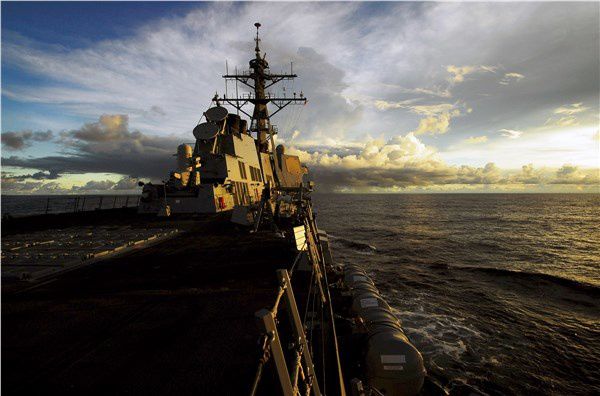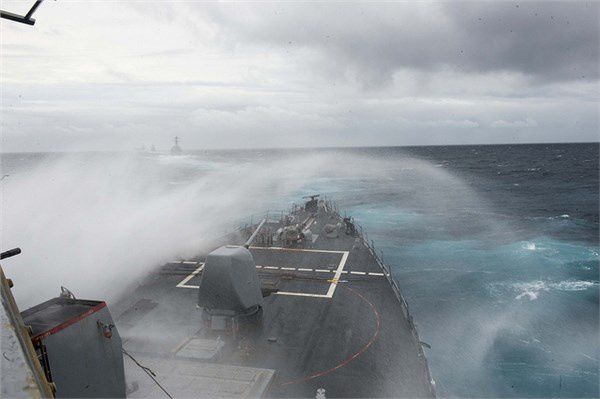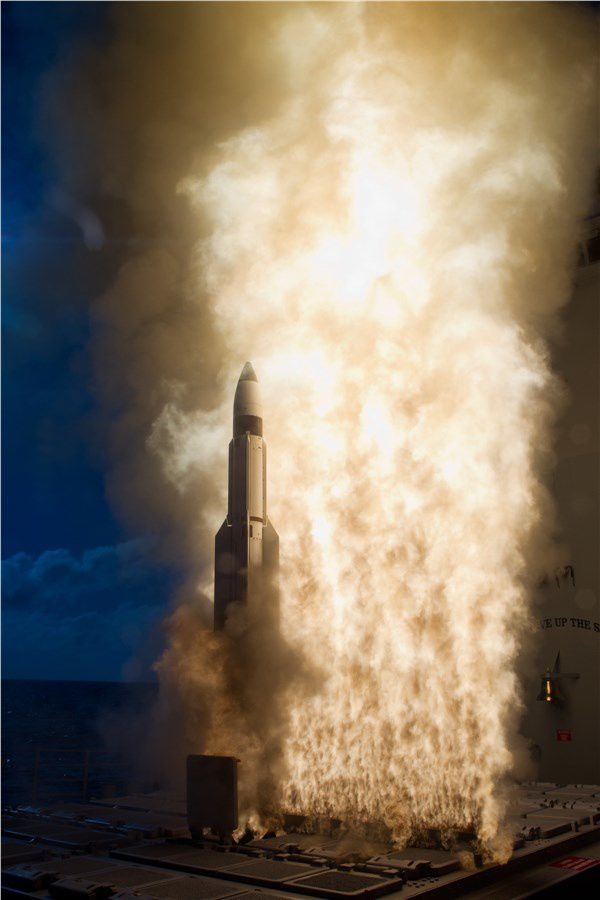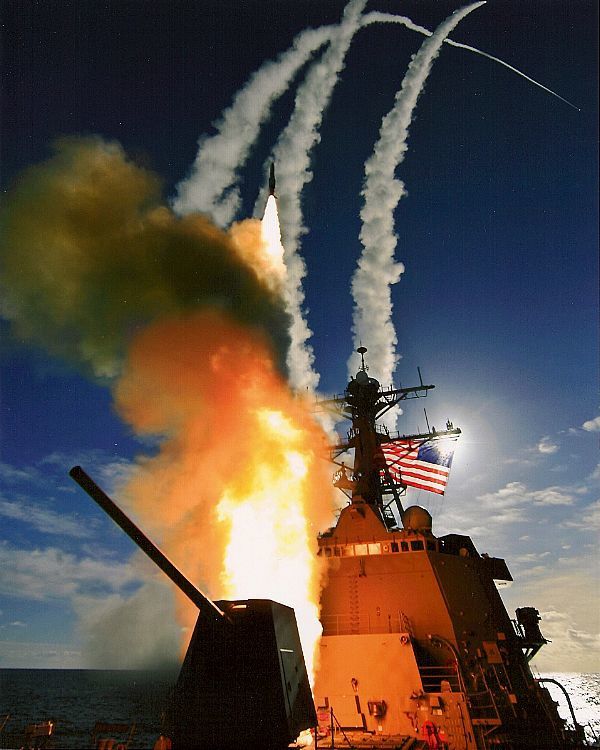May 31st, 2013 by Kris Osborn -defensetech.org
Stellar Avenger successful ballistic missile defense intercept.The Pentagon’s Missile Defense Agency and the U.S. Navy are developing next-generation Aegis ballistic missile defense (BMD) hardware and software along with a longer-range interceptor missile engineered to massively increase the protective envelope against intermediate and long-range ballistic missile threats, service officials said.
The Navy and Lockheed Martin are now developing and testing computer code for what’s called Aegis BMD 5.0 and 5.1 Weapons Systems, the next iterations of technology designed to provide Aegis destroyers and cruisers with advanced radar, intercept and signal processing capabilities, said Navy Capt. Jim Kilby, Deputy for Aegis BMD.
The hardware and software for these systems are now being tested and refined at a Combat Systems Engineering Development Site in Moorestown, N.J.
“The code is now in test. Instead of having a normal ballistic missile signal processor, 5.0 will have a multi-mission signal processor,” said Kilby. “Lockheed Martin is testing this code in the final stages right now for stability and endurance.”
Aegis BMD destroyers routinely patrol waters in the Pacific Ocean, using cutting-edge radar technology to scan the surrounding skies for potential missile threats.
These routine patrols, part of the U.S. Navy’s Pacific Fleet’s regular deployments and maritime security routines, have taken on additional importance in light of recently escalating tensions and potential threats emanating from North Korea.
“The purpose of the Aegis ships on patrol in the Pacific is a mission called Long Range Surveillance and Track and they act as sensors for homeland ballistic missile defense,” Kilby said. “In simple terms, their job is to provide an early detection of intercontinental ballistic missiles[ICBM] and provide fire control quality tracking data to the Ground-based Midcourse Defense system.”
This tracking data would enable Ground-based Interceptor (GBI) missiles, from either Fort Greeley, Alaska, or Vandenberg Air Force Base, California, to intercept the ICBM before it could reach targets in the United States, said Kilby.
Overall, this kind of scenarios speaks to the broader multi-layered aspects of the U.S. missile defense posture, Kilby explained.
In total, the Navy’s Pacific Fleet is home to 16 Aegis BMD ships.
“The capability our AEGIS Ballistic Missile Defense (BMD) ships provide is in great demand. Longer, more frequent deployments have become more common. The Navy is busy. We expect to continue to be busy into the future as the operational requirements for our naval forces continues,” said Navy Lt. Anthony Falvo, spokesman for the Navy’s Pacific Fleet.
Aegis BMD ships are known, in large measure, for their AN/SPY-1 radar system which surveys the surrounding atmosphere for potential threat objects in a 360-degree envelope, electronically scanning around the ship and up to high altitudes every twelve seconds, Navy officials indicated.
Then, once a threat is located by the radar, the ship’s MK 72 booster fires one of several possible Standard Missile-3’s out of what’s called a MK 41 Vertical Launch System, propelling the interceptor into space to collide with and destroy an approaching missile threat.
Aegis BMD Weapons Systems are designed in “increments” such that each new iteration is designed to build upon and add to substantial existing capability. The new systems are engineered to build upon the progress of the recently tested Aegis BMD 4.0 Weapons System technology.
“4.0 has a ballistic missile signal processor called the BSP and the SM-3 Block IB has a two-color seeker. These two things give you more discrimination ability from the kill vehicle and more discrimination from a tracking or radar perspective,” he added.
Discrimination ability is described as having the technological capability to discern an incoming missile from surrounding debris, decoy objects or even fuel waste, Kilby explained.
Aegis BMD Weapons System 5.0 is now being integrated on the USS John Paul Jones, a guided-missile destroyer based at Naval Homeport, San Diego, Calif.
“The USS John Paul Jones has commercial-off-the-shelf computing technologies such as blade servers that are more similar to what is out in industry right now,” said William Doud, BMD special assistant.
In fact, the first sea trials involving the integration of an engineering load of Aegis BMD Weapons System 5.0 were completed earlier this month, a Navy official said.
“After the industrial portion of her availability ends this September, she [USS John Paul Jones] will have about a year of testing and certification trials to certify this combat system for installation in other ships,” the Navy source indicated.
Once complete in 2016, the Aegis BMD Weapons System 5.1 will be ready for installation, testing and certification aboard the USS John Paul Jones; Initial Operational Capability for Aegis BMD Weapons System 5.1 is currently slated for 2018, a Navy official said.
“The USS John Paul Jones will become the BMD test ship year from now,” Kilby added.
The Standard Missile-3 Block IIA interceptor, to be ready by 2018, is being designed to integrated with the Aegis BMD Weapons System 5.1; the missile will travel much further above the earth’s atmosphere compared to prior missiles and bring an improved ability to identify, discriminate and destroy incoming enemy ballistic missiles, said Kilby.
The SM-3 Block IIA, and it predecessor, the recently tested SM-3 Block IB, are designed to intercept intercontinental ballistic missiles during the Midcourse phase of their trajectory — essentially that period of time during which the missile is traveling through space above the earth’s atmosphere, Kilby explained.
The SM-3 Block IIA, currently being co-developed by the U.S. and Japan, has a 21-inch nose cone, large-diameter kinetic warhead and what’s called an advanced discrimination seeker, Kilby explained.
“The Block IIA has much more room for fuel and a bigger warhead. It goes faster and farther,” said Doud — comparing the SM-3 Block IIA to the SM-3 Block IB which recently intercepted a dummy warhead above the Pacific Ocean during a test-firing from the USS Lake Erie.
The May 15 test was conducted by Navy sailors aboard the USS Lake Erie, a guided-missile cruiser, which detected and tracked the missile with its on-board AN/SPY-1 radar, according to an MDA press statement.
The development of the SM-3 Block IIA and test of the MDA’s BMD system utilizing the Aegis Weapon System 4.0 as well as the SM-3 Block IB are also significant with regard to the Pentagon’s longer term Aegis Ashore program, referred to as a European Phased Adaptive Approach (PAA).
Both of the SM-3 Block IB and the SM-3 Block IIA missiles have a more advanced seeker and more advanced “Throttleable Divert/Attitude Control System (TDACS),” when compared with prior models of the missile such as the SM-3 Block 1A missile.
“Once it is ejected from the missile in space, the TDACS points the Kinetic Warhead’s (KW) IR sensor in the expected direction of the incoming ballistic missile, acquires it, and then diverts the KW so as to cause a hit-to-kill collision with the incoming threat missile,” a Navy official explained.
The Aegis Ashore plan calls for an effort to build and insert land-based SM-3 Block IB missiles at fixed sites in Romania and Poland, by 2015 and 2017, respectively.
The concept is for the “fixed” or land sites to work in tandem with Aegis ships within range in order to widen the BMD protective envelope across wider swaths of the globe, improving protection for the continental U.S. and key U.S. allies, Kilby explained.
“Aegis sites ashore and Aegis ships at sea will be connected via satellite data link and share both sensor and engagement data just as when ships are operating together at sea,” he said.


























/http%3A%2F%2Fwww.hurriyetdailynews.com%2Fimages%2Fnews%2F201304%2Fn_45107_4.jpg)



